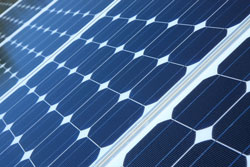US chemists have shown that trace impurities – below the sensitivity of standard characterisation techniques – can halve the efficiency of bulk heterojunction (BHJ) solar cells. Their finding means that initially promising materials for device applications may have been written off prematurely owing to their low efficiencies.

Trace impurities are difficult to detect owing to their similarity to donor molecules in solar cells. The impurities can significantly influence photovoltaic properties
Unlike traditional inorganic solar cells, polymer cells do not immediately create charge carriers but instead create electron-hole pairs called excitons over a donor-acceptor interface, which migrate to the electrodes. In BHJ solar cells, the donor-acceptor blend is mixed, creating this interface throughout the cell and transporting the charge carriers to the electrodes through an interpenetrating network. Although this network shows a significant improvement in efficiency over traditional cells, it is also highly sensitive to impurities, which can affect the carrier mobility and act as traps, increasing the chance of charge recombination before the exciton reaches an electrode.
A team led by Guillermo Bazan and Alan Heeger from the University of California, Santa Barbara, noticed that organic semiconductors’ effectiveness could vary from batch to batch. As the power conversion efficiencies of BHJ solar cells depend on the average molecular weight of the polymer, the team started by examining the definition of the structures and found that trace impurities in the donor of below 1% could halve device performance.
Read the full article in Chemistry World
Link to journal article
Role of trace impurities in the photovoltaic performance of solution processed small-molecule bulk heterojunction solar cells
Wei Lin Leong , Gregory C. Welch , Loren G. Kaake , Christopher J. Takacs , Yanming Sun , Guillermo C. Bazan and Alan J. Heeger
Chem. Sci., 2012, Advance Article, DOI: 10.1039/C2SC20157G










